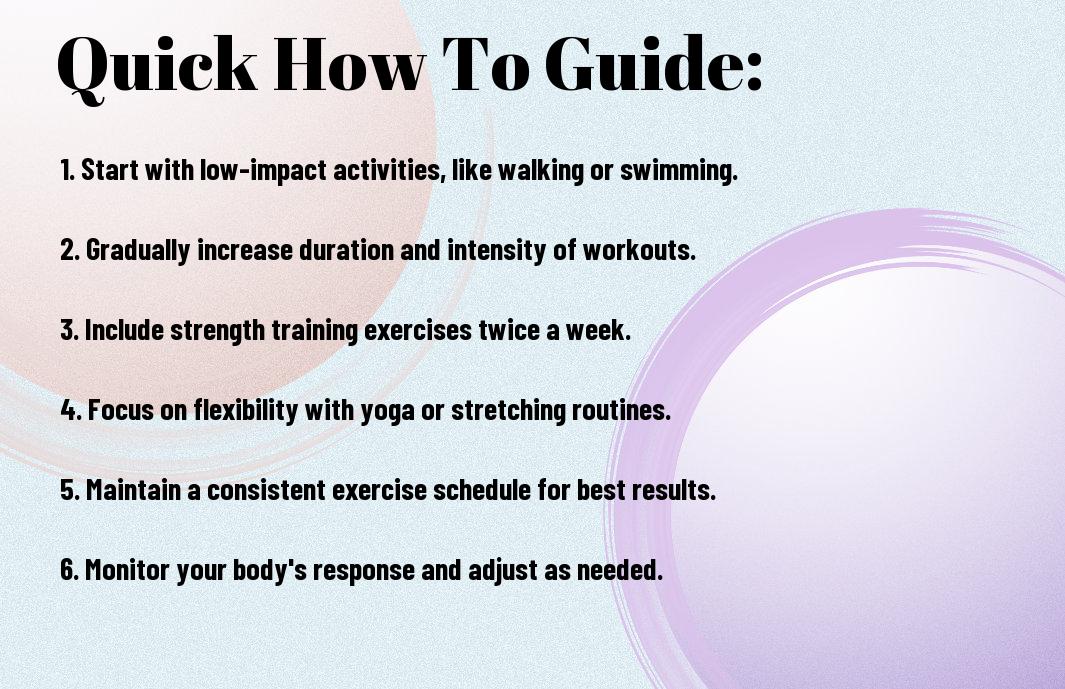As you seek to manage chronic inflammation, you can take control of your health by incorporating exercise into your daily routine. Regular physical activity can help reduce inflammation and alleviate debilitating symptoms. By making informed choices about your exercise habits, you can harness the anti-inflammatory effects of physical activity to improve your overall well-being and mitigate the risk of associated diseases. You will learn how to tailor your exercise routine to achieve these benefits and start feeling the positive impact on your body.
Key Takeaways:
To reduce inflammation through exercise, consider the following points:
- Regular Physical Activity can help decrease inflammation by improving insulin sensitivity and promoting weight loss, which are both associated with lower levels of inflammatory markers in the body.
- Aerobic Exercise, such as brisk walking, cycling, or swimming, is particularly effective in reducing systemic inflammation by enhancing the body’s natural anti-inflammatory processes.
- Incorporating Strength Training into your routine can also help reduce inflammation by building muscle mass, which has anti-inflammatory properties and can further contribute to overall health.
- Yoga and other mind-body exercises have been shown to decrease the production of Pro-inflammatory cytokines, which are molecules that promote inflammation, thereby contributing to a reduction in overall inflammation levels.
- Starting with Moderate Intensity exercises and gradually increasing the intensity and duration can help the body adapt and minimize the risk of injury, making it more likely to stick to an exercise regimen and achieve the goal of reducing inflammation.

Understanding Inflammation
To effectively reduce inflammation, you need to understand what it is and how it affects your body.
What is Inflammation
You should know that inflammation is a natural response of your body’s immune system, which helps to protect you from infections and injuries.
Factors that Contribute to Inflammation
An analysis of your lifestyle will show that factors such as poor diet, lack of exercise, and stress contribute to inflammation, including:
- Genetics
- Environmental toxins
Assume that addressing these factors will help you reduce inflammation.
Factors such as smoking, obesity, and chronic stress also contribute to inflammation, including:
- Poor sleep
- Sedentary lifestyle
Assume that making changes to your lifestyle will help you reduce inflammation and improve your overall health.
Benefits of Exercise in Reducing Inflammation
Clearly, regular exercise is a key component in reducing inflammation in the body. By incorporating physical activity into your daily routine, you can experience numerous benefits, including reduced inflammation, improved overall health, and a lower risk of chronic diseases.
How Exercise Affects the Body
Aside from the obvious benefits, exercise has a profound impact on your body’s internal systems, helping to minimize inflammatory responses and promote healing. As you engage in physical activity, your body begins to adapt, leading to improved cardiovascular health and enhanced immune function.
Tips for Starting an Exercise Routine
Bodily awareness is imperative when starting a new exercise routine, you should consider your current fitness level and health goals. Some tips to get you started include:
- starting with low-intensity exercises
- incorporating stretching and flexibility exercises
- listening to your body and resting when needed
Knowing how to balance your routine will help you achieve your goals and minimize the risk of injury.
Tips for creating an effective exercise routine include setting realistic goals and tracking your progress. Some additional considerations are:
- incorporating strength training to build muscle mass
- engaging in cardiovascular exercises to improve heart health
- practicing mind-body exercises to reduce stress
Knowing how to tailor your routine to your individual needs will help you achieve optimal results and maintain a healthy lifestyle.

Types of Exercise for Reducing Inflammation
Your exercise routine can include:
- Aerobic
- Strength training
| Exercise | Benefits |
|---|---|
| Yoga | Pain reduction |
| Swimming | Low-impact |
| Cycling | Improved cardiovascular health |
| Walking | Mobility improvement |
| Jogging | Weight management |
Assume that you will notice improvements in your overall health.
Low-Impact Exercises
Likewise, low-impact exercises are ideal for reducing inflammation and improving mobility. You can try activities like yoga or swimming to minimize strain on your joints.
High-Intensity Exercises
Clearly, high-intensity exercises can be beneficial for weight management and improving cardiovascular health. You can try activities like jogging or cycling to boost your metabolism.
The high-intensity exercises can be challenging and may cause injury if not done properly. You should consult with a healthcare professional before starting any new exercise routine. Proper training and equipment are vital to minimize risk and maximize benefits. You will notice significant improvements in your overall health and wellness with a well-planned exercise routine.

Creating a Personalized Exercise Plan
All individuals can benefit from a personalized exercise plan to reduce inflammation. You can find The Top Exercises to Reduce Pain and Inflammation and create a routine that suits your needs.
Assessing Your Fitness Level
Fittingly, you should assess your current fitness level to determine the best exercises for you. This will help you identify areas that need improvement and prevent injuries.
Setting Realistic Goals
Planned carefully, your exercise routine should have attainable objectives. You will be more likely to stick to your plan if you set realistic goals.
Level of commitment is key when setting realistic goals. As you progress, you can increase the intensity and duration of your workouts, but it’s necessary to start slow and listen to your body. You should aim to make sustainable lifestyle changes that reduce inflammation and improve your overall health. By doing so, you will be more likely to achieve long-term success and maintain a healthy weight.

Nutrition and Lifestyle Factors
After incorporating exercise into your routine, consider the impact of nutrition and lifestyle on inflammation. You can reduce inflammation by:
- avoiding processed foods
Assume that Foods That Reduce Inflammation After the Gym will help you make informed decisions.
How Diet Impacts Inflammation
For instance, your diet plays a significant role in inflammation levels, with some foods exacerbating the issue.
Lifestyle Changes to Support Exercise
For optimal results, you should focus on making lifestyle changes that support your exercise routine, such as getting enough sleep.
It is vital to prioritize self-care and make conscious choices about your daily habits, as this will help youmaintain a healthy balance between exercise and rest. You can significantly reduce inflammation by making these changes, leading to a healthier and Overcoming Challenges and Staying Motivated
Many people struggle to incorporate exercise into their daily routine, but The Anti-Inflammatory Actions of Exercise Training – PMC can help. You can stay motivated by setting realistic goals and tracking your progress. As you learn more about the benefits of exercise, you will be more likely to stick to your routine. Any number of obstacles can stand in the way of your exercise routine, including lack of time or injury. You may find it difficult to get started, but finding an enjoyable activity can make it easier to stick to your routine. There’s no one-size-fits-all approach to maintaining a consistent exercise routine, but finding a supportive community can help. You can also try to mix up your routine to avoid boredom and prevent plateaus. Exercise is a key component of reducing inflammation, and maintaining a consistent routine is crucial. You can start by scheduling your workouts and tracking your progress, which will help you stay motivated and accountable. As you continue to exercise, you will begin to notice positive changes in your body, such as reduced inflammation and improved overall health. By making exercise a priority, you can take control of your health and reduce your risk of chronic diseases. From above, you now understand how exercise can help reduce inflammation in your body. You’ve learned how regular physical activity can decrease inflammatory markers and improve overall health. By incorporating exercise into your daily routine, you can take control of your inflammation and improve your well-being. You will be able to make informed decisions about your health and develop a fitness plan that works best for you. A: Exercise has been shown to have anti-inflammatory effects, which can help to reduce inflammation in the body. Regular physical activity can help to improve immune function, reduce oxidative stress, and promote the production of anti-inflammatory cytokines. Additionally, exercise can also help to reduce inflammation by improving insulin sensitivity, reducing body fat, and promoting the health of the gut microbiome. By incorporating exercise into your daily routine, you can help to reduce inflammation and improve overall health. A: Aerobic exercises, such as brisk walking, cycling, and swimming, have been shown to be effective in reducing inflammation. These types of exercises can help to improve cardiovascular health, reduce oxidative stress, and promote the production of anti-inflammatory cytokines. Additionally, high-intensity interval training (HIIT) and strength training exercises have also been shown to have anti-inflammatory effects. It’s also important to incorporate low-impact exercises, such as yoga and tai chi, which can help to reduce stress and promote relaxation, both of which can contribute to inflammation. A: The frequency and duration of exercise needed to reduce inflammation can vary depending on the individual and their current level of physical activity. The American Heart Association recommends at least 150 minutes of moderate-intensity aerobic exercise per week, which can be broken down into 30 minutes per day, five days a week. Additionally, incorporating strength training exercises two to three times per week can also help to reduce inflammation. It’s also important to listen to your body and start slowly, especially if you’re new to exercise, and gradually increase the intensity and duration as you become more comfortable. A: While exercise is an important component of reducing inflammation, it’s not the only factor. A healthy diet that is rich in fruits, vegetables, whole grains, and lean protein sources can also help to reduce inflammation. Additionally, getting enough sleep, managing stress, and avoiding environmental toxins can also contribute to reducing inflammation. It’s also important to work with a healthcare professional to identify and address any underlying medical conditions that may be contributing to inflammation. By making lifestyle changes that incorporate exercise, healthy eating, and stress management, you can help to reduce inflammation and improve overall health. A: Yes, there are several precautions you should take when starting an exercise program to reduce inflammation. It’s imperative to consult with a healthcare professional before starting any new exercise program, especially if you have any underlying medical conditions or concerns. Additionally, it’s imperative to listen to your body and start slowly, especially if you’re new to exercise. It’s also important to warm up before exercise, cool down afterwards, and stay hydrated to avoid injury or exacerbating inflammation. Furthermore, it’s imperative to choose exercises that are low-impact and gentle on the joints, especially if you have any underlying joint issues or concerns. By taking these precautions, you can help to ensure a safe and effective exercise program that reduces inflammation and improves overall health.Common Obstacles to Exercise
Strategies for Maintaining a Consistent Routine
Summing up
FAQ
Q: What are the benefits of exercise in reducing inflammation?
Q: What types of exercise are most effective in reducing inflammation?
Q: How often should I exercise to see a reduction in inflammation?
Q: Can exercise alone eliminate inflammation, or are there other lifestyle changes that need to be made?
Q: Are there any precautions I should take when starting an exercise program to reduce inflammation?


